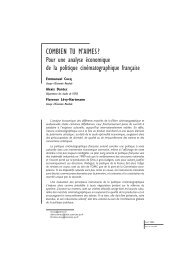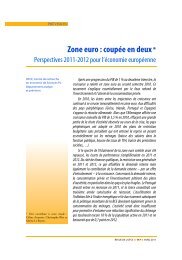direct multi-step estimation and forecasting - OFCE - Sciences Po
direct multi-step estimation and forecasting - OFCE - Sciences Po
direct multi-step estimation and forecasting - OFCE - Sciences Po
You also want an ePaper? Increase the reach of your titles
YUMPU automatically turns print PDFs into web optimized ePapers that Google loves.
Direct <strong>multi</strong>-<strong>step</strong> <strong>estimation</strong> <strong>and</strong> <strong>forecasting</strong><br />
that the formula most appropriate to <strong>multi</strong>-<strong>step</strong> <strong>forecasting</strong> cannot always be derived from an<br />
ARMA model. The results would asymptotically be the same if the estimators were computed to<br />
maximize the forecast log-likelihood. Findley remarks that when the forecast accuracy criterion<br />
combines several horizons, the degree of complexity is much higher. In order to improve forecast<br />
accuracy, it may seem desirable to use several lags of the variable. Findley suggests an h-<strong>step</strong><br />
Akaike Information Criterion (AIC h ) in order to select the order of the AR(p) to be fitted (for p<br />
smaller than some p max ). The order p is thus given by:<br />
where:<br />
p = argmin<br />
1≤p≤p max<br />
{AIC h (p)} ,<br />
AIC h (p) = T 0 log<br />
[<br />
2π.SSQ<br />
(̂φ1 , ..., ̂φ<br />
) ]<br />
p /T 0 + T 0 + 2 (p + 1) ,<br />
T 0 = T − p max − h + 1,<br />
<strong>and</strong><br />
(̂φ1 , ..., ̂φ<br />
)<br />
p is computed as the set of coefficients which minimizes the in-sample sum of the<br />
squared h-<strong>step</strong> ahead residuals:<br />
SSQ ( φ 1 , ..., φ p<br />
)<br />
=<br />
∑ T −h<br />
t=p max<br />
(<br />
y t+h − ∑ p<br />
k=1 φ ky t−k+1<br />
) 2<br />
.<br />
The author applies his results to two st<strong>and</strong>ard time series: series C <strong>and</strong> E from Box <strong>and</strong> Jenkins<br />
(1976), where autoregressive models are fitted using the AIC h criterion. The results exhibit an<br />
average gain for the proposed <strong>multi</strong>-<strong>step</strong> methods in terms of MSFE of about 4% for series C at<br />
horizons 5 <strong>and</strong> 10, <strong>and</strong> respectively 2.6% <strong>and</strong> 10.6% for series E at horizons 5 <strong>and</strong> 10.<br />
Liu (1996) suggests to modify the st<strong>and</strong>ard fitting criteria for the order of an autoregressive<br />
process to allow for the inclusion of <strong>multi</strong>-<strong>step</strong> forecast errors. He proposes to partition the data<br />
set into non-overlapping vectors of length h, where h is the maximum desired forecast horizon.<br />
Estimating the resulting VAR by weighted least-squares is shown by the author to be leading<br />
asymptotically to the same estimates as those of a univariate model, but at a loss of efficiency.<br />
In a Monte Carlo simulation for samples of size 80 <strong>and</strong> 240, Liu compared the ratios of 2- <strong>and</strong><br />
4-<strong>step</strong> ahead root MSFEs. The results showed little improvement by using the <strong>multi</strong>-<strong>step</strong> methods,<br />
whether the data were generated by either a zero-mean stationary AR(1) or an ARI(1, 1). The<br />
author applies his methods to <strong>forecasting</strong> the quarterly U.S. (174 observations) <strong>and</strong> monthly Taiwan<br />
(192 obs.) unemployment rates, the log of quarterly real U.S. G.N.P. (179 obs.) <strong>and</strong> the monthly<br />
18








